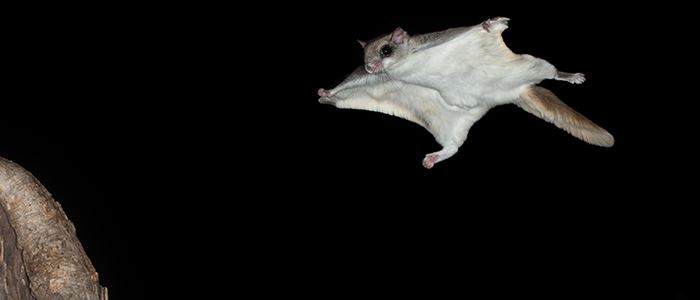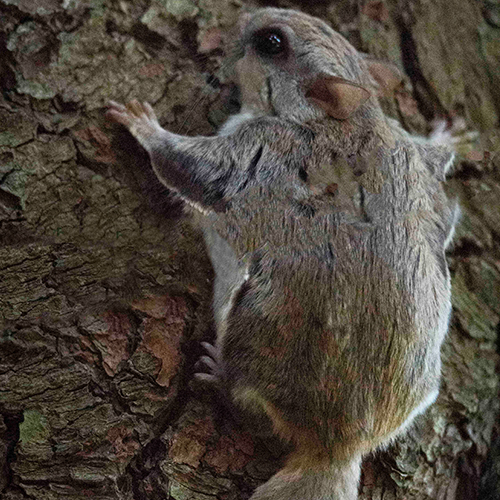Canopy Cruisers

By Karen Menard
What goes up, must come down.
When evening arrives, some of the Metropark woodlands come alive with eight inch long, airborne rodents called southern flying squirrels (Glaucomys volans). Having successfully mastered the art of the glide, these small, aerodynamically-skilled mammals are able to quickly and easily ride the breeze down from the treetops to the bottoms of tree trunks. Their nightly voyages are all accomplished with fur and not feathers.
Cruising below the tree canopy sometimes at speeds of up to 20 mph comes easy with the use of a patagium or gliding membrane-- flaps of loose skin extending from wrist to ankle. The amount of slack created on either side of it controls the speed, angle and course of the glide while creating air resistance, similar to how a parachute works. Keep in mind that, at times, leaps and glides can total an impressive distance of over 150 feet from heights of 60 feet!
While sailing through the air, the squirrel’s body position gradually tilts from horizontal to vertically upright as it prepares to reach its destination. During this short time, the force of lift increases, eventually rotating rearward, better allowing the animal to slowly control its landing as it raises the front part of its body.
Another physical adaptation that aids in the reduction of drag during the landing process includes raised tips of cartilage positioned behind each wrist. This special tissue is designed to bend upward, shaped similar to the ends of airplane wings, minimizing drag, improving overall stability, and also cushioning the landing. The tail also assists as a steering mechanism.
Once the squirrel lands on a tree trunk, it is on a mission for morsels! Considered omnivorous, they seek out berries, insects, eggs, fungi, hickory nuts and acorns and are usually active all night during the warmer months. In fact, an individual has the ability to cache several hundred acorns a night and approximately 15,000 in a season.

Most commonly found in mixed deciduous forests with abundant oaks and some hickories, southern flying squirrels are considered a part of healthy, forest ecosystems and inhabit trees with cavities or snags. They also play an important role in the dispersal of seeds, nuts and fungal spores.
The next time you are out at night in a wooded area, pay special attention to any high-pitched squeaks or trills that are heard in the darkness. It just might be a flying squirrel getting ready to launch itself into the shadows in search of its next meal.
Did You Know?
The southern flying squirrel is considered the most common squirrel in Ohio. The flying squirrel was also the inspiration for a “wingsuit,” in the shape of an aerofoil, (used in extreme sports), allowing the wearer to glide through the sky at high speeds.
---
Photos: Southern flying squirrel gliding (stock photo); Southern flying squirrel: ArtWeber